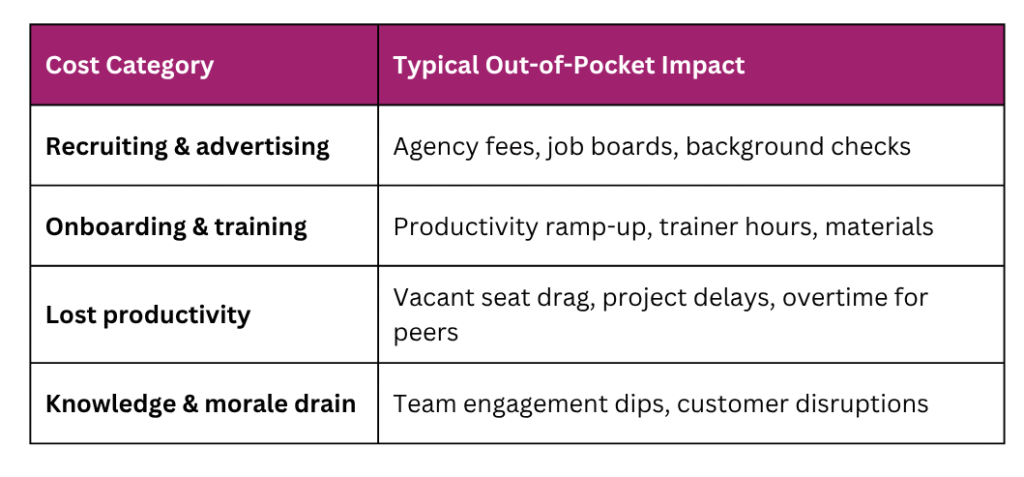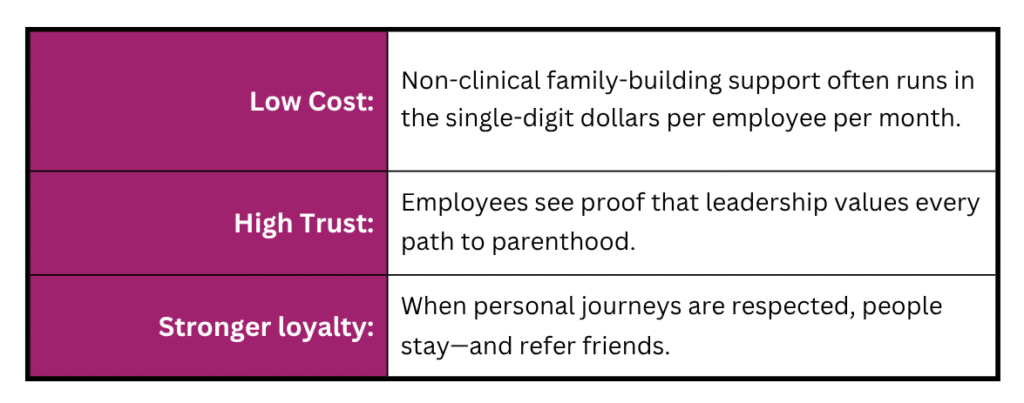Few line items drain a budget faster than unexpected turnover. SHRM research places replacement costs at 50% – 200% of an employee’s salary. Gallup estimates U.S. businesses forfeit about $1 trillion annually to voluntary exits. When leaders and managers leave, that figure rises even higher. Here’s where the money goes:

Work Institute’s 2025 Retention Report claims the all-in average at one-third of annual pay for each departure.
Why People Leave in 2025
Exit interviews keep circling back to the same five reasons:
- Lack of growth or development
- Poor manager relationships
- Work-life imbalance
- Compensation gaps
- Benefits that don’t match real needs
That last point matters more than ever as the definition of family is evolving, and equitable access across all family types is key. Some employees turn to adoption or surrogacy after fertility challenges; others start there by choice.
Within any team you’ll find:
- Relatives—sometimes grandparents—formally adopting children oftentimes due to tragedy
- LGBTQ+ couples growing families through surrogacy, donor eggs, or adoption
- Single professionals pursuing parenthood on their own
- Foster and guardianship paths that lead to permanent homes
Benefits as a Retention Tool, Not a Perk
Standard health coverage and PTO are the baseline. Employees now expect support that reflects their realities—whether adoption, foster care, surrogacy, or egg donation.
Here’s why investing in family-forming support pays off:

Case Snapshot: The Brooks Family
One employee family used Vesta’s grant guidance to secure $17,000 toward adoption fees—a reminder that navigation can outweigh large cash reimbursements.
Their note said it best: “Without guidance we wouldn’t have known where to start.”
Supported employees stay focused and engaged instead of scanning job boards.
The Math in Plain Sight
A 100-person company with an average salary of $70K:
- One regrettable exit: $35K – $140K in replacement and ramp-up costs.
- A full-year journey navigation program for every employee: well under 10% of that single turnover hit.
Prevent just one departure and the benefit pays for itself—everything after that is savings.
Even better, candidates notice. Offering inclusive family-building support—whether or not it includes reimbursement—shows you value every path to parenthood and helps your organization stand out in a crowded talent market.
Action Checklist for HR Leaders
- Audit hidden costs. According to SHRM, calculating turnover is as simple as: (Number of separations ÷ average number of employees) × 100. You can find member-access templates on SHRM’s website or explore data-driven reports like Work Institute’s annual Retention Report to understand the true cost of losing talent.
- Listen strategically. Run a short, anonymous pulse survey that asks employees: “Which family-building supports would make you proud to stay here?”…..”What benefits would you tell friends about when recommending us?”
- Keep questions broad (navigation, flexible leave, financial guidance) so answers aren’t skewed toward high-dollar reimbursements few will use.
- Pilot an inclusive benefit. Start with early-stage coaching and resource guidance. Add modest reimbursement later if demand and budget allow. Navigation alone delivers meaningful impact at a fraction of the cost of large lump-sum payouts.
- Track retention. Compare turnover and engagement before and after launch.
- Share success stories. Highlight employee journeys—such as the Brooks family—to show leaders and peers how navigation plus targeted grants can move mountains while keeping costs in check.
Put the Numbers to Work
Turnover will always exist, but it doesn’t have to derail the budget. Affordable, inclusive navigation-first benefits lift morale and help you keep your best people.








